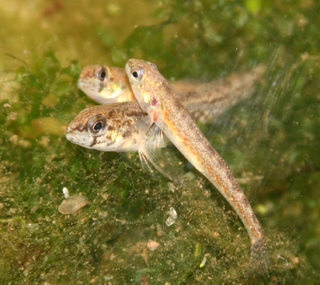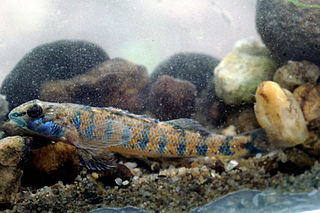
The bluegill, sometimes referred to as "bream," "brim," "sunny," or, as is common in Texas, "copper nose", is a species of North American freshwater fish, native to and commonly found in streams, rivers, lakes, ponds and wetlands east of the Rocky Mountains. It is the type species of the genus Lepomis, from the family Centrarchidae in the order Perciformes.

The spoonhead sculpin is a species of freshwater ray-finned fish belonging to the family Cottidae, the typical sculpins. This species is widespread in northeastern North America.

Hoplosternum littorale is a species of catfish belonging to the Callichthyinae subfamily of the family Callichthyidae. It is known as tamuatá in Brazil, atipa in French Guiana, hassa in Guyana, kwi kwi in Suriname, cascadu or cascadura in Trinidad and Tobago, and busco or currito in Venezuela.

The bayad, is a species of bagrid catfish from Africa.

The channel darter is a species of freshwater ray-finned fish, a darter from the subfamily Etheostomatinae, part of the family Percidae, which also contains the perches, ruffes and pikeperches. It is native to North America where it typically occurs in the sandy or gravelly shallows of lakes and in small and medium-sized rivers in riffles over sand, gravel or rock bottoms. It is a small fish ranging from 34 to 72 mm in length, olive brown with darker speckles and sometimes with a dark spot below the eye and dark blotches along the flank. It feeds mostly on insect larvae and other small invertebrates and breeds in small streams. This species is listed as threatened by the Canadian Species at Risk Act (SARA) but overall it has a wide range and numerous sub-populations and the International Union for Conservation of Nature has rated it as a "least concern species".

The vermilion darter is a species of freshwater ray-finned fish, a darter from the subfamily Etheostomatinae, part of the family Percidae, which also contains the perches, ruffes and pikeperches. It is endemic to the southern United States, where it only is found in Turkey Creek in Jefferson County, Alabama, part of the Mobile Bay drainage basin. It was first described by Herbert Boschung in 1992, who was the curator of ichthyology at the University of Alabama, along with biologist Richard Mayden and scientific illustrator Joseph Tomelleri. On December 7, 2010, the US Fish and Wildlife Service designated 13 mi (21 km) of Turkey Creek watershed as critical habitat for the darter. According to the IUCN, the population of this fish is declining.

The fantail darter is a species of freshwater ray-finned fish, a darter from the subfamily Etheostomatinae, part of the family Percidae, which also contains the perches, ruffes and pikeperches. It is widely distributed across streams in North America.

Etheostoma exile, the Iowa darter, is a species of freshwater ray-finned fish, a darter from the subfamily Etheostomatinae, part of the family Percidae, which also contains the perches, ruffes and pikeperches. It is, along with about 17 other species of darters, is native to the lakes and streams of Iowa.

The mud darter is a species of freshwater ray-finned fish, a darter from the subfamily Etheostomatinae, part of the family Percidae, which also contains the perches, ruffes and pikeperches. It is endemic to the lowlands of the Mississippi River basin from Wisconsin and Minnesota south to Louisiana and East Texas. It is also found in the drainages of the Sabine and Neches Rivers of Texas and Louisiana. It can be found in slow-moving waters on riffles in rivers, as well as in creeks, swamps, lakes, and reservoirs. It mostly consumes the larvae of midges and blackflies. This species can reach a length of 7.1 cm (2.8 in), though most only reach a length of 5 cm (2.0 in).

The bluntnose darter is a species of freshwater ray-finned fish, a darter from the subfamily Etheostomatinae, part of the family Percidae, which also contains the perches, ruffes and pikeperches. It is found in eastern North America where it is found in slower moving and still waters.

The swamp darter is a species of freshwater ray-finned fish, a darter from the subfamily Etheostomatinae, part of the family Percidae, which also contains the perches, ruffes and pikeperches. It is endemic to the Eastern United States.
The least darter, is a species of freshwater ray-finned fish, a darter from the subfamily Etheostomatinae, part of the family Percidae, which also contains the perches, ruffes and pikeperches. It is generally found in lakes and streams in northeastern part of the United States and along the Mississippi River systems.
The lollipop darter is a species of freshwater ray-finned fish, a darter from the subfamily Etheostomatinae, part of the family Percidae, which also contains the perches, ruffes and pikeperches. It is endemic to the eastern United States. Lollipop darters are approximately 1.4 to 2.4 inches long.
The arrow darter is a species of freshwater ray-finned fish, a darter from the subfamily Etheostomatinae, part of the family Percidae, which also contains the perches, ruffes and pikeperches. It is found in parts of Kentucky and Tennessee, particularly in the Cumberland and Kentucky Rivers. These small fish are part of the perch family. They grow to be about 4.5 inches (11 cm) in length. Their opercle, breast, and cheek are all unscaled. They have a vertical black bar at the base of their caudal fin. Six to nine vertical banded bars run down the side of the fish. The dorsal side of the fish is olive green in color, and the ventral side is a yellow to white pattern. The first dorsal fin has a black base, followed by green color, and then a reddish-orange end. The second dorsal is clear with two rows of laterally lined orange spots. The caudal fin is clear and has two-three vertical lines of orange spots. The anal fin has a green base and then clear at the end. The breeding male has bright orange-red spots and breeding tubercles present on the scales.
The Tippecanoe darter is a species of freshwater ray-finned fish, a darter from the subfamily Etheostomatinae, part of the family Percidae, which also contains the perches, ruffes and pikeperches. It is endemic to the eastern United States.
The wounded darter is a species of freshwater ray-finned fish, a darter from the subfamily Etheostomatinae, part of the family Percidae, which also contains the perches, ruffes and pikeperches. It is endemic to the eastern United States. Its range includes the upper Tennessee River drainage, western Virginia, western North Carolina, and eastern Tennessee. Its typical habitat is among boulders or coarse rubble and cobble, often with overhanging ledges, in medium to large slow-moving rivers. It feeds on small insect larvae, especially midge larvae. Spawning occurs when the water warms up in late spring. Females deposit clutches of adhesive eggs on the underside of rock ledges or slabs, and the male guards the nest. The population trend of this fish seems to be decreasing slowly but it is a relatively common species with numerous sub-populations, and the International Union for Conservation of Nature has assessed its conservation status as being of "least concern". The greatest threat comes from impoundment, and a management plan is in place, including captive breeding.
Percina phoxocephala, the slenderhead darter, is a species of freshwater ray-finned fish, a darter from the subfamily Etheostomatinae, part of the family Percidae, which also contains the perches, ruffes and pikeperches. It is found in North America in the central Ohio and Mississippi River basins, to northeastern South Dakota and the Lake Winnebago system in Wisconsin, and as far south as the Red River in eastern Oklahoma and northeast Texas, typically in small to medium size rivers. It is a colorful species, with an average length of 6 to 9 centimeters. Males take on a deeper hue during the breeding season. It feeds on insect larvae and other small invertebrates, and spawns between April and June. It is a common fish with a very wide range and the International Union for Conservation of Nature has classified its conservation status as being of "least concern".

The speckled darter is a species of freshwater ray-finned fish, a darter from the subfamily Etheostomatinae, part of the family Percidae, which also contains the perches, ruffes and pikeperches. It is endemic to the central and southeastern United States. It occurs in the Mississippi River basin and through the Gulf Coast drainages. It is also found in the Clinch River and the Powell River. This species inhabits rocky or sandy pools in flowing waters up to the size of medium rivers with fast currents. It can reach a length of 6.1 centimetres (2.4 in) TL though most only reach about 4 centimetres (1.6 in).

The tessellated darter is a species of freshwater ray-finned fish, a darter from the subfamily Etheostomatinae, part of the family Percidae, which also contains the perches, ruffes and pikeperches. It is native to Canada and the United States. It was formerly considered a subspecies of the johnny darter, which it greatly resembles in general appearance.

The Savannah darter is a species of freshwater ray-finned fish, a darter from the subfamily Etheostomatinae, part of the family Percidae, which also contains the perches, ruffes and pikeperches. It is endemic to the eastern United States, where it occurs in the Edisto, Combahee, Broad and Savannah River drainages in South Carolina and Georgia. It inhabits gravel riffles, gravel and sand runs of creeks and small rivers. This species can reach a length of 7.4 cm (2.9 in).















